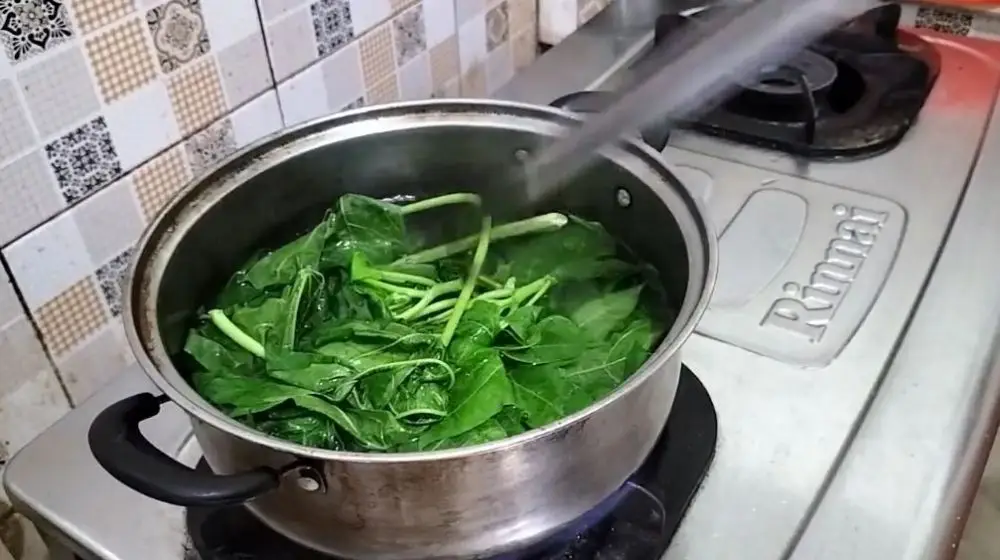Brilio.net - Papaya leaves are often used as a complement to main dishes and can be processed with various typical Indonesian spices. In addition, these leaves can also be eaten directly after being boiled. However, the bitter taste produced by the saponin compound makes many people reluctant to consume it.
Fortunately, the bitter taste can be removed with the right boiling technique. Special techniques can speed up the boiling process and reduce the bitter taste. A YouTube user, APSHA TV, shares how to boil papaya leaves using one effective kitchen spice to speed up the softening and remove the bitter taste.
"This time I want to give you a recipe on how to boil papaya leaves so that they are not bitter and remain green without using food coloring," said YouTube APSHA TV, quoted by BrilioFood on Wednesday (8/1).
The only seasoning used is salt. The method is to prepare water in a pan and boil it until it boils.

photo: YouTube/APSHA TV
While waiting for the water to boil, prepare the papaya leaves. In the video, he uses a mixture of young and old papaya leaves. Well, these young papaya leaves will be boiled with the stems. While for the old papaya leaves, just take the leaves. Make both types of leaves one and wash them clean.

photo: YouTube/APSHA TV
When the water is boiling, add 1 tbsp of salt. Stir until the salt dissolves. Then add the papaya leaves that have been washed clean. Stir while pressing so that the papaya leaves are completely submerged.
"If possible, use a lot of water so that the papaya leaves can sink like this," he explained further.

photo: YouTube/APSHA TV
Reported from online-journal.unja.ac.id, the addition of salt has various functions. First, salt can increase the boiling point of water. This will make papaya leaves soft in a short time. Second, salt can help neutralize saponin compounds, the cause of the bitter taste. Third, salt can maintain the natural green color of papaya leaves.
Next, boil the papaya leaves for 5 minutes only in an open pan. Avoid covering the pan because the steam will be trapped and can fall back into the boiling water. If the steam falls into the papaya decoction, it can risk making the taste bitter and the color turning black.

photo: YouTube/APSHA TV
Once boiled for 5 minutes, immediately remove the papaya leaves and soak them in cold water. This will stop the boiling process, which will turn the papaya leaves black. In addition to being fresh green, the taste is no longer bitter and the texture of the leaves is perfectly soft.
Viewed more than 1,000 times, this video immediately caught the attention of netizens. Through the comments column, there are other YouTube users who admit to being amazed by the results of papaya leaves that are soft and still fresh green.
"Wow, this is really green... watch the full package," said YouTube @bundadari635.
Papaya leaves are not only delicious to eat, but also have various nutritional contents that are beneficial for health. These leaves are rich in vitamins A, C, and E which act as antioxidants. In addition, papaya leaves contain the enzyme papain which helps digestion and fiber which is good for the body's metabolism. Several studies have also shown that papaya leaves have anti-inflammatory properties and can help increase platelet production in the blood.
Variations of papaya leaf dishes in Indonesian cuisine.In various regions of Indonesia, papaya leaves are processed in different ways to suit local tastes. In Manado, papaya leaves are the main ingredient in Garo Bunga Pepaya, cooked with skipjack tuna. Meanwhile, in Java, papaya leaves are often processed into stir-fries with the addition of anchovies or meat. In Sumatra, papaya leaves are usually cooked in curry with coconut milk and special spices. The diversity of these preparations shows how papaya leaves have become an important part of Nusantara cuisine.
Storage techniques and shelf life of papaya leaves.To maintain the freshness of papaya leaves, there are several storage techniques that can be applied. Fresh papaya leaves can last 3-4 days if stored in a closed container in the refrigerator at a temperature of 4-10C. Before storing, make sure the leaves are dry and wrapped in tissue paper or newspaper to absorb excess moisture. Boiled papaya leaves can be stored for up to 2 days in the refrigerator. For long-term storage, papaya leaves can be frozen after boiling and can last up to 1 month.
(brl/lut)